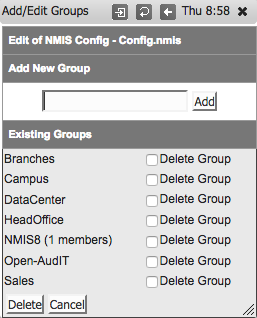The default configuration that NMIS8 ships with can be turned into a working system fairly quickly. If you are looking to get NMIS8 set-up quickly and just want the basics to start off with, this is the guide for you. If you are looking for more in-depth descriptions see NMIS8 Configuration. If you haven't downloaded NMIS yet, you can access the software here.
It is often advantageous to group individual nodes, or devices, into Groups to improve dashboard views and reporting. This is especially important when working with opCharts, as it allows geographical notification of group status, reducing the number of icons being represented.
While NMIS ships with a set of default Groups built-in, most users will want to add custom groupings. Groups are single level and cannot be nested. Therefore, it is imperative some thought and consideration be given to the creation of groups and assignment of nodes. If you plan to use opCharts you should consider creating Groups based on a specific geographic location. Otherwise, Group definition is most often defined by device type (Routers, switches, etc), business function (core, perimeter, offsite, etc), or manufacturer (Cisco, Juniper, etc).
Σ - To help with monitoring and troubleshooting make sure you have a dedicated group to contain your primary or Primary NMIS server and any additional critical nodes. NMIS ships with the default NMIS8 Group
Group definitions are contained in the NMIS config file - config.nmis - but this can be edited through the NMIS interface by selecting Setup > Add/Edit Groups from the NMIS menu.

The Add/Edit Groups window Allows direct editing of the group_list field from the config.nmis file.
NOTE: The group list should contain NO SPACES; this includes between group names comprised of multiple words (use an underscore _ ), or following the group name. However, within the terminal commas are used to separate the different groups.

Once you have completed adding your group, click the Add button to confirm or Cancel to close the dialogue box. The NMIS Configuration window will open, centred on the group_list, to allow you to confirm the change. When you are satisfied simply close this window.
For more on Groups: NMIS8 Groups
There are two basic ways to monitor a node, using SNMP or using ping. Each node requires, at a minimum, 4 attributes to be set in order for it to be monitored.
Σ - You should always add your NMIS server as the first device to be monitored. This will ensure you receive status reports regarding the health of the monitoring systems themselves. If you split databases across servers make sure to add those devices as well, and any nodes that connect the web server and the database server(s) together. These nodes should then be grouped into a NMIS specific Group.
Each node requires, at a minimum, 4 attributes to be set. These are marked with a red asterisk next to the properties name and are the first four properties in the Add/Edit Nodes and Devices window.
* The “SNMP Community string” is like a user id or password that allows access to a router's or other device's statistics. SNMP Community strings are used only by devices which support SNMPv1 and SNMPv2c protocol. If the community string is correct, the device responds with the requested information. If the community string is incorrect, the device simply discards the request and does not respond. By convention, most SNMPv1-v2c equipment ships from the factory with a read-only community string set to "public".
This is the section about Node Customization
This is the section about System Configuration
The default contact is named Contact1 and should be left with this name. We need to set the email address, and phone numbers if you like.
By default, NMIS8 has the user Contact1 notified on all events for the first couple of escalation levels (0 and 2), because we set the email address for Contact1 emails will start to flow immediately, no changes need to be made. After you receive the first couple of messages you may find yourself wanting to make some modifications to the default settings.
For more detailed information on any of these topics or any other topics that are not covered here see NMIS8 Configuration